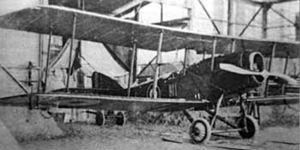Martinsyde G.100
| G.100/G.102 "Elephant" | |
|---|---|

| |
| Role | fighter/day bomber |
| Manufacturer | Martinsyde |
| First flight | 1915 |
| Introduction | 1916 |
| Primary users | Royal Flying Corps Australian Flying Corps |
| Number built | 271 |
The Martinsyde G.100 "Elephant" and the G.102 were British fighter bomber aircraft of the First World War built by Martinsyde. The type gained the name "Elephant" from its relatively large size and lack of manoeuvrability. The G.102 differed from the G.100 only in having a more powerful engine.
Design and development
An unusually large aircraft by contemporary standards for a single-seater, the Elephant two-bay equal span staggered biplane was designed by A A Fletcher of the Martinsyde Company, a prototype powered by a 120 hp Austro-Daimler engine entering test in the autumn of 1915.
The initial production version, the G.100, was powered by a 120h p six-cylinder Beardmore engine and was armed with a single 0.303 in drum-fed Lewis Gun mounted above the centre section. This was later augmented by a similar weapon bracket-mounted to the port fuselage side behind the cockpit).
The G.100 was gradually succeeded by the G.102 with a 160 hp Beardmore engine. Maximum speed of the 160 hp aircraft was 108 mph (174 km/h) at sea-level falling to 100 mph (160 km/h) at 10,000 ft; it had a maximum ceiling of 14,000 ft (4,300 m).[1]
Operational use
The G.100 was built originally as a long range, single-seat fighter and escort machine but on the basis of its size and weight was reclassified as a day bomber.
Deliveries to the RFC commenced in mid 1916, a total of 270 being manufactured. The G.100 and G.102 Elephants were used in France and the Middle East, although only No. 27 Squadron, RFC was completely equipped with this type.
While not particularly successful as a fighter owing to its poor agility by comparison other fighters of the times, the Elephant performed a useful service in long-range bombing, carrying up to a 260 lb (120 kg) bomb load. It successfully performed this role from the summer of 1916 through to late 1917. It was also used for long-range photo reconnaissance, where stability and endurance were required (the type was capable of a five-and-a-half-hour flight).
Variants
- Martinsyde G.100 : Single-seat fighter-scout, bomber and reconnaissance biplane, powered by a 120 hp (89 kW) Beardmore piston engine. 100 built.[2]
- Martinsyde G.102 : Single-seat fighter-scout, bomber and reconnaissance biplane, powered by a 160 hp (119 kW) Beardmore piston engine. 171 built.[2]
Operators
- Royal Flying Corps[2][4]
- No. 14 Squadron RFC
- No. 18 Squadron RFC
- No. 20 Squadron RFC
- No. 21 Squadron RFC
- No. 23 Squadron RFC
- No. 25 Squadron RFC
- No. 27 Squadron RFC
- No. 30 Squadron RFC
- No. 31 Squadron RFC
- No. 39 Squadron RFC
- No. 51 Squadron RFC
- No. 63 Squadron RFC
- No. 72 Squadron RFC
- No. 110 Squadron RFC
- No. 142 Squadron RFC
Specifications (G.100)
Data from The British Fighter since 1912[2]
General characteristics
- Crew: One, pilot
Performance
- Endurance: 4.5 hours
Armament
- Guns:
** 1 × 0.303 in Lewis gun mounted above upper wing centre section- 1 × Lewis gun mounted fixed aft of the cockpit pointing rearwards
- Bombs: 260 lb (120 kg) bombload
See also
Related lists
References
- ^ a b c d Flight 1920 p641
- ^ a b c d Mason, Francis K (1992). The British Fighter since 1912. Annapolis, Maryland: Naval Institute Press. pp. Pages 44–45. ISBN 1-55750-082-7.
- ^ Cutlack, F.M. (1941) [1923]. "Appendix 1 Types of Fighting Aeroplanes". The Australian Flying Corps in the Western and Eastern Theatres of War 1914–1918. Vol. Volume VIII (11th ed.). Sydney: Angus and Robertson. p. 404. Retrieved 10 March 2008.
{{cite book}}:|volume=has extra text (help);|work=ignored (help); External link in|chapterurl=|chapterurl=ignored (|chapter-url=suggested) (help) - ^ Mason, Francis K (1994). The British Bomber since 1914. London: Putnam Aeronautical Books. pp. 74–75. ISBN 0-85177-861-5.
- Kenneth Munson Aircraft of World War I, 1967 Ian Allan ISBN 0-7110-0356-4
- "Milestones: The Martinsyde Machines" (pdf), Flight: 637–638, 641, 17 June 1920
External links
- Martinsyde G.100 - The Aerodrome
